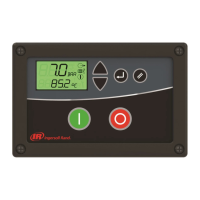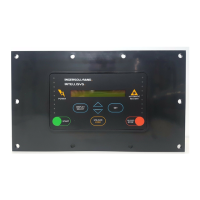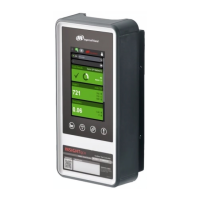SGNe Troubleshooting Guide Page 25
Revision 1.0; Davidson, May 2009. ©Ingersoll Rand Proprietary Information
SGNe
Troubleshooting Guide
Danger
Please utilize extreme caution when performing work within the compressor cabinet.
When opening the cabinet: be certain to wear appropriate PPE (Personal Protective Equipment),
follow lock out-tag out procedures, and ensure all safety procedures are followed
.
High Temperature Recovery
If the unit approaches a high airend discharge temperature condition, will reduce the
maximum speed of the compressor and possibly keep the unit from having a high
airend discharge temperature.
The logic is as follows: if the airend discharge temperature reaches 222 degF, the
Intellisys will reduce the maximum speed of the compressor by 5%. At 223 degF, it will
reduce the maximum speed by another 5%. This will
continue to a maximum speed
reduction of 30% at 227 degF.
Once the temperature
drops 2 degF from its high, the Intellisys will add 5% back to the
maximum speed. For
example, if the airend discharge temperature reached 226 degF
and the maximum
speed was reduced by 25%, when the temperature falls to 224, the
Intellisys will add
5% back to the maximum speed. This will continue until the airend
discharge temperature falls to 219 degF and the maximum speed is no longer reduced.
Alarms
If a critical value is exceeded (during any mode of operation; i.e. loaded, unloaded,
stopped, etc.), an alarm sequence shall take place.
In this sequence, the controller
shall flash a large exclamation mark in a triangle on the
display screen while removing
power from the starter contactor. The display should also
indicate what caused the
alarm in addition to its recorded measurement.
Power shall not be issued back to the
starter until the alarm message has been reset and
the alarm parameters have returned to normal range.
The operator resets the alarm b
y pressing the RESET twice. These alarms are archived in
the controller memory for future reference (up to 15 alarm
s total). Each stored alarm will be
referred to as an “Alarm History.” Multiple, consecutiv
e EMERGENCY STOP Alarms will not
be recorded as separate alarms; only the first on
e will be shown.
An ALARM STATUS screen (reached by depressing the STATUS button) should allow the
operator to view the list of machine operating conditions that existed at the time of the Alarm.
The name and value of each of the items listed should be available for viewing through the
use of the UP and DOWN buttons. The operator should then be able to return to the Alarm
screen by pressing the ALARM button. The following sections describe each alarm message
and the conditions associated with each (the controller logic must be de-bounced for each
alarm).
High Airend Disch Temp
Will occur if 2ATT is greater than 228 degF during normal operation. This alarm will occur
at 190 degF if the unit is in idle mode.
Blower Fault
Will occur if the fault contact opens on the blower VSD.

